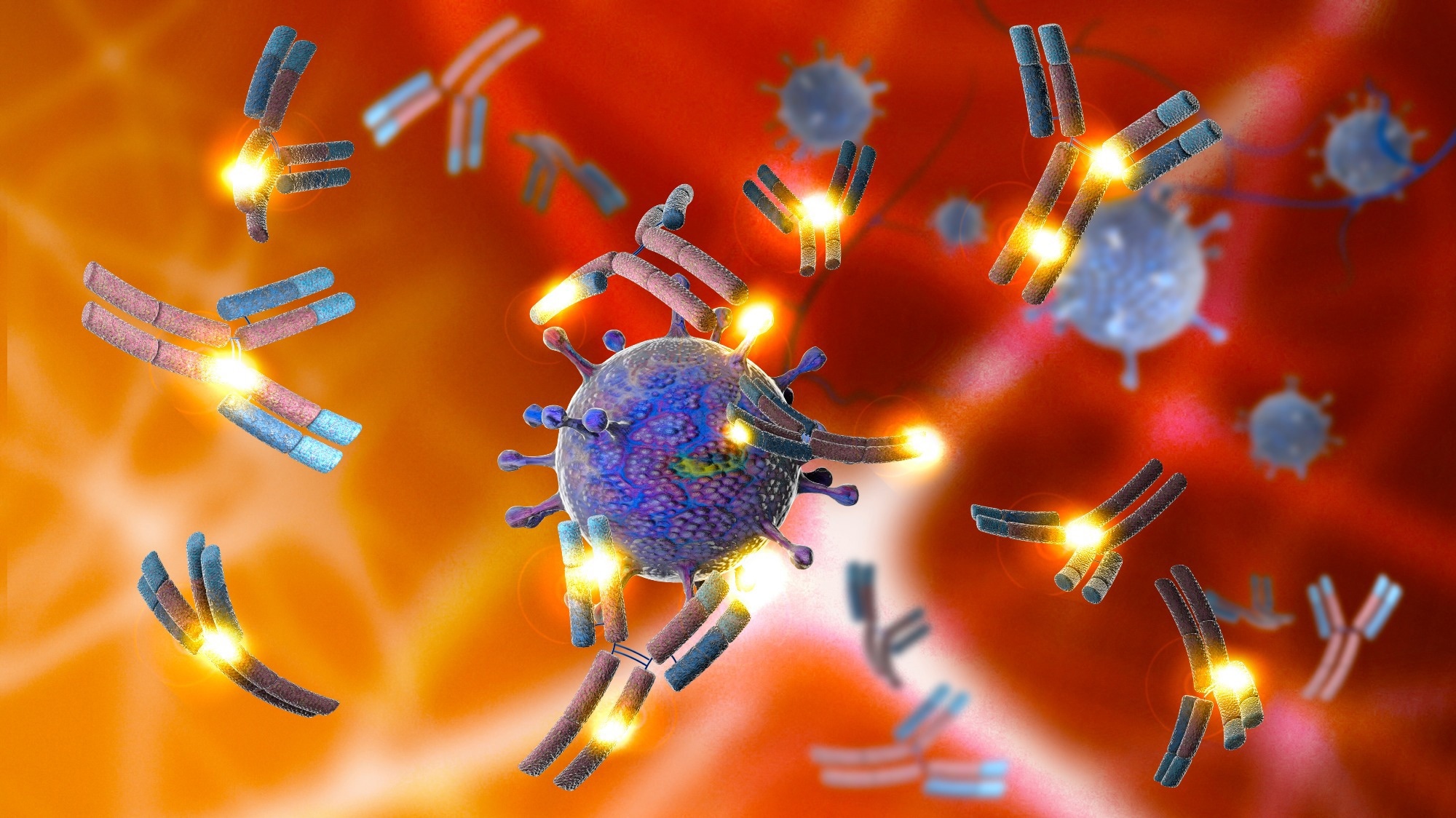In a recent study posted to the bioRxiv* preprint server, researchers in Taiwan and the United States explore the resistance of a newly emergent severe acute respiratory syndrome coronavirus 2 (SARS-CoV-2) Omicron sub-variant BA.4.6 to the therapeutic monoclonal antibodies currently being used to treat coronavirus disease 2019 (COVID-19).
 Study: Resistance of SARS-CoV-2 Omicron Subvariant BA.4.6 to Antibody Neutralization. Image Credit: Naeblys / Shutterstock
Study: Resistance of SARS-CoV-2 Omicron Subvariant BA.4.6 to Antibody Neutralization. Image Credit: Naeblys / Shutterstock
Background
The Omicron sub-variant BA.4.6 is a recent cause for concern because of its rapid expansion despite the presence of the other widespread sub-variant BA.5. Furthermore, the two new mutations, R346T and N658S, in the receptor binding domain (RBD) of the BA.4.6 spike protein indicate its potential to evade the therapeutic monoclonal antibodies currently being used to combat COVID-19.
A similar mutation (R346K) in the BA.1.1 sub-variant had resulted in antibody evasion. Two other sub-variants, BA.4.7 and BA.5.9 have also been detected at low frequencies, with mutations R346S and R346I, respectively. The efficacy of the existing repertoire of monoclonal antibodies needs to be tested against these mutated subvariants to ensure immunity against the rapidly emerging and evolving sub-variants of SARS-CoV-2.
About the study
The present study compared the spike protein binding affinity of the Omicron sub-variants BA.4.6, BA.4.7, and BA.5.9 against that of the globally dominant BA.5 sub-variant. The assays included the spike proteins from the lineages carrying R346T, R346S, and N658S point mutations and the spike proteins of the BA.4 and B.4 sub-lineages.
The researchers tested the antibody evasion properties of the three Omicron sub-variants by subjecting the corresponding pseudoviruses to neutralization using serum samples from vaccinated individuals who had received their second booster shot (three doses in total) and mRNA-vaccinated individuals who had BA.1 or BA.2 infections.
A panel of 23 monoclonal antibodies was used to measure the sensitivity of BA.4.6, BA.4.7, and BA.5.9 to neutralization. The 23 monoclonal antibodies were selected based on effectiveness against earlier Omicron subvariants and diversity of the target epitope clusters on the RBD of the spike protein. The neutralization assays also included monoclonal antibodies currently in clinical use.
Results
The study results showed that Omicron sub-variants BA.4.6, BA.4.7, and BA.5.9 exhibited similar binding affinities to the dimeric human angiotensin-converting enzyme 2 (hACE2) receptor compared to the BA.5 subvariant. The pseudoviruses carrying point mutations also displayed binding affinities similar to BA.4.6.
The three subvariants were equally resistant to the serum from vaccinated individuals with booster shots. The pseudoviruses carrying point mutations for R346T, R346S, and N658S showed a similar trend. The sub-variants BA.4.6, BA.4.7, and BA.5.9 also exhibited equivalent resistance to the serum from vaccinated BA.1-infected patients. However, BA.4.6 was significantly more resistant to the serum from vaccinated BA.2-infected patients than BA.5.
In the neutralizing assays, the monoclonal antibodies that target epitope cluster class 3 of the RBD showed reduced neutralization potency against BA.4.6, BA.4.7, and BA.5.9. The authors believe this reduction in efficacy is due to the R346T and R346S mutations but not the N658S mutation. The R346T and R346S mutations were seen to weaken or remove the salt bridges or hydrogen bonds which aid in the R346 residue binding to the RBD class 3 monoclonal antibodies.
Additionally, the therapeutic monoclonal antibody combination of cilgavimab and tixagevimab was found to be ineffective against all three newly emergent mutated sub-variants.
Conclusions
Overall, the study results suggest that the spread of the newly emergent SARS-CoV-2 Omicron subvariant BA.4.6 cannot be attributed to the R346T and N658S spike protein mutations increasing its receptor binding affinity. Moreover, the resistance of the BA.4.6 sub-variant to the serum from vaccinated BA.2-infected patients was significantly higher than that of the other sub-variants but not large enough to explain the worldwide expansion of BA.4.6 conclusively.
The loss of neutralization activity of a widely used combination of monoclonal antibodies tixagevimab and cilgavimab is concerning. Currently, bebtelovimab is the only potent therapeutic monoclonal antibody against all the circulating SARS-CoV-2 variants and sub-variants. However, the resistance of the new sub-variants to the monoclonal antibodies in clinical use leaves a large population of immunocompromised individuals vulnerable to the rapidly mutating sub-variants of SARS-CoV-2.
*Important notice
bioRxiv publishes preliminary scientific reports that are not peer-reviewed and, therefore, should not be regarded as conclusive, guide clinical practice/health-related behavior, or treated as established information
- Resistance of SARS-CoV-2 Omicron Subvariant BA.4.6 to Antibody Neutralization: Qian Wang, Zhiteng Li, Jerren Ho, Yicheng Guo, Andre Yanchen Yeh, Michael Liu, Maple Wang, Jian Yu, Zizhang Sheng, Lihong Liu, and David D Ho. bioRxiv. 2022, DOI: https://doi.org/10.1101/2022.09.05.506628, https://www.biorxiv.org/content/10.1101/2022.09.05.506628v1
Posted in: Medical Science News | Medical Research News | Disease/Infection News
Tags: Angiotensin, Angiotensin-Converting Enzyme 2, Antibodies, Antibody, binding affinity, Coronavirus, Coronavirus Disease COVID-19, covid-19, Efficacy, Enzyme, immunity, Monoclonal Antibody, Mutation, Omicron, Protein, Receptor, Respiratory, SARS, SARS-CoV-2, Severe Acute Respiratory, Severe Acute Respiratory Syndrome, Spike Protein, Syndrome
.jpg)
Written by
Dr. Chinta Sidharthan
Chinta Sidharthan is a writer based in Bangalore, India. Her academic background is in evolutionary biology and genetics, and she has extensive experience in scientific research, teaching, science writing, and herpetology. Chinta holds a Ph.D. in evolutionary biology from the Indian Institute of Science and is passionate about science education, writing, animals, wildlife, and conservation. For her doctoral research, she explored the origins and diversification of blindsnakes in India, as a part of which she did extensive fieldwork in the jungles of southern India. She has received the Canadian Governor General’s bronze medal and Bangalore University gold medal for academic excellence and published her research in high-impact journals.
Source: Read Full Article
